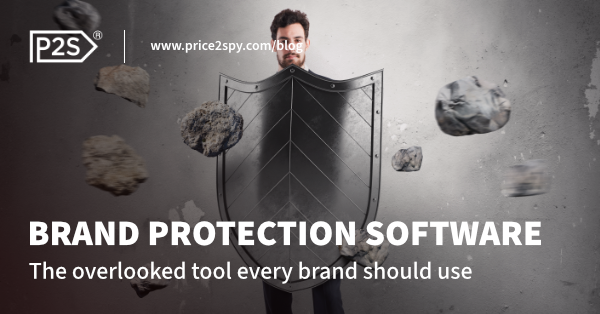
Brand Protection Software: The Overlooked Tool Every Brand Should Use
Brand protection software is used for monitoring trademark violations, brand mentions, unauthorized marketplace listings, and even setting up anti-piracy measures. In the background the majority of these tools work by crawling different websites (e.g. marketplaces, social media, app stores, etc.) and then collect evidence and generate various reports.

However, more and more, brands have begun to realize that protecting their value and upholding their image in their customers’ eyes is also tightly related to their pricing policy. Or, to be more precise, how consistently their resellers implement it. This is why price monitoring tools that can monitor for minimum advertised price (MAP) violations are starting to be considered as one additional subtype of brand protection software.
But how do MAP monitoring tools actually help brands uphold their value? Let’s take a look.
The underrecognized lever: MAP monitoring as brand protection
MAP policies define the lowest price a reseller may advertise. They do not set the price a reseller must sell at. MAP exists to prevent a public race to the bottom that erodes perceived value and triggers channel conflict.
It is important not to confuse MAP with MSRP (Manufacturer’s Suggested Retail Price). MAP is most often a contractual limit on how low a product can be advertised for, whereas MSRP is in a large majority of cases, nothing more than a suggestion.
When it comes to MAP violations, though, they are a slow way to erode a brand. Exactly because it’s slow, it usually goes “under the radar” of many brands. This is especially true for those brands that do not utilize a brand protection software of any kind.
Persistent under-MAP ads signal “this brand is cheap,” confuse customers, anger compliant partners, and invite grey-market arbitrage. That is classic brand risk, not just a pricing nuisance. Treating MAP compliance as a brand-protection problem closes the loop between equity, trust, and revenue.
5 reasons to use MAP monitoring as part of brand protection
Protect brand equity and positioning
A stable public price floor preserves perceived quality. It keeps your premium narrative credible and avoids teaching customers to wait for a perpetual deal.
Prevent channel conflict and churn
Compliant partners leave when they cannot compete with rogue ads. Fast detection and consistent enforcement keep honest resellers invested in your line.
Cut margin erosion and price wars at the root
One under-MAP ad often triggers a cascade across the channel. Early alerts stop copycat repricing before it propagates to marketplaces and comparison engines.
Create enforceable, auditable leverage
Evidence packs, violation histories, and resolution SLAs turn awkward conversations into an objective process. You gain grounds to restrict supply, withhold MDF, or adjust tiers.
Quantify impact and improve decisions
Reporting links violations to Buy Box loss, gross margin, and brand search CTR. You can prioritize high-impact SKUs, refine policy, and target education where it moves revenue.
MAP enforcement as a method of brand protection in practice
MAP enforcement only makes sense if you know the price your customers actually see. Price monitoring tools look for that price across stores and ads, match it to the right product, and save proof. If a price is advertised below MAP, they flag it and send it to the right person. Here are the key steps in this process.
Data acquisition at scale
Brand protection software (or tool) checks where customers see your prices: retailer sites, marketplaces, Shopping ads, social ads, and comparison engines. It collects for each SKU across countries, currencies, and devices, and repeats on a schedule so short-lived promos are not missed. It also grabs proof at the moment of capture, like screenshots and the HTML around the price.
Detection logic that handles obfuscation
Many sellers hide the real price. Brand protection software follows the same steps a shopper would: opens the page, applies visible coupons, adds to cart, and continues to checkout if needed. It can strikethroughs, “price in cart,” auto-applied discounts, rebates, and shipping that quietly lowers the total. For bundles and multi-packs, it calculates a per-unit price.
Alerting and workflow
When a violation is found, it is routed to the right owner by reseller, region, or account. High-impact SKUs and repeat offenders can trigger priority alerts. Duplicates are grouped, and false positives can be snoozed. You get one-click actions: send a friendly notice, file a marketplace claim, or escalate. Every step is logged with timestamps, notes, and evidence so conversations stay factual.
Policy modeling
Your MAP is encoded exactly as you run it in real life: by SKU, region, currency, reseller type, and date range. You can define what “advertised” means for your brand, including feeds and in-cart prices shown without login. Promo exceptions and MAP “holidays” have clear start and end times. There are rules for rounding, VAT or sales tax inclusion, shipping, and per-unit math for bundles. This makes detection fair, consistent, and defensible.
Bottom line
Classic brand protection removes fakes and impersonators. Add MAP monitoring and you also remove the price signals that quietly degrade your brand every day. If you model policy precisely, detect the real tactics sellers use, and enforce consistently with evidence, MAP becomes one of the most effective brand-protection controls you have.



